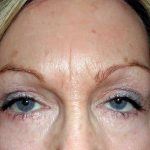One of the manifestations of aging of the forehead is changes in position or shape of the eyebrow. While it is generally believed that one’s brow falls or descends with age, current studies suggest that this is not always true. I have seen numerous patients where the eyebrows are clearly lower than the edge of the brow bone but have observed other patients where the eyebrows seem ‘high’ for their age. Men with thicker skin and heavier foreheads seem to suffer greater eyebrow descent than women. Whether one’s eyebrows are too low later in life undoubtably has a lot to do with where they started.
Browlifting is a common treatment for rejuvenation of the forehead. While there are numerous techniques for forehead surgery, they all work to elevate the eyebrows with varying degrees of success at abnormal muscle modification particularly between the eyebrows. One of the great fears of most patients about browlifting is that of overelevation of the eyebrows making one look like a ‘deer in the headlights’. Too much browlifting is easy to do since the patient is laying horizontal during surgery and the perspective of what one looks like in a more natural vertical position is lost.

It is important that patients appreciate, unlike eyelid surgery, that changing the eyebrows is not as precise. It is difficult to obtain exacting millimeter brow position and shape control. This is particularly true in endoscopic techniques where measured skin or scalp removal is not done. In my Indianapolis plastic surgery practice, I emphasize to patients the browlift concepts of subtle to moderate improvement and getting a more rejuvenated shape of which they decide what that is.
Barry L. Eppley, M.D., D.M.D.
Indianapolis, Indianapolis



